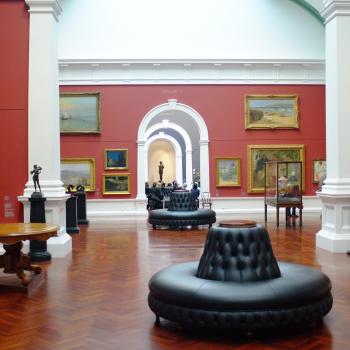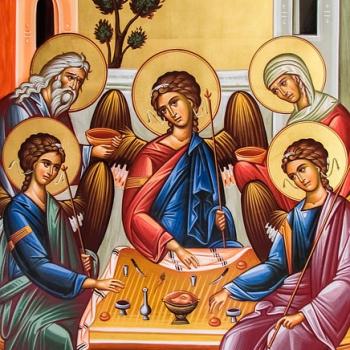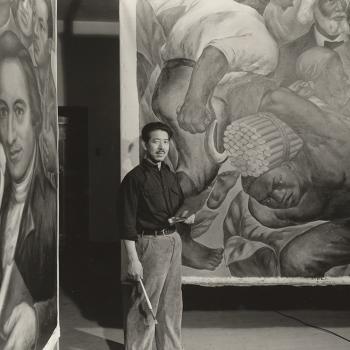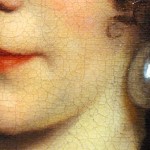Part Two: Beyond the Image
Guest Post
By Daniel Siedell
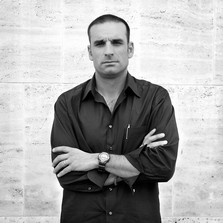 Have you ever been underwhelmed by a painting? Have you been excited to see a well-known and often reproduced painting on tour at your local art museum, your hopes built up to be utterly transformed and…nothing?
Have you ever been underwhelmed by a painting? Have you been excited to see a well-known and often reproduced painting on tour at your local art museum, your hopes built up to be utterly transformed and…nothing?
Often the painting appears tiny and timid, even vulnerable, surrounded by a crowd of people thinking the very same thing you are. Or it appears less colorful, less dynamic than it had in the glossy reproduction in the magazine or on banners that peaked your interest.
Perhaps we’re embarrassed by our response, feeling that we’re missing something that someone else (a specialist like me, for instance) has clearly seen.
This has happened to me, more times than you might imagine. Far from being a lack of knowledge or taste, it is built into the nature of a painting itself.
Our expectations of a famous painting, whether it’s Leonardo’s Mona Lisa, Picasso’s Old Guitarist, or Munch’s The Scream, are built on our desire to see an image, an image we’ve seen in newspapers, magazines, television commercials, coffee mugs, T-shirts, and other merchandise. We are coming to experience the aura of a spectacle generated by the image.
We come to the museum and wait in line to see that image. And then we are disappointed.
So, for many artists, critics, and curators, not to mention well-meaning art lovers, the frequency of this disappointment seems to point to the fact that painting is dead or outmoded; that it is incapable of offering a powerful experience in our intensely visual age. In this context, painting—let’s just put it out there—is a boring image.
But a painting is not an image.
It is something more. An artist once shocked me by declaring that painting often distracts us by what it looks like. For him, what is most interesting about a painting is not what we think is most important. How can this be?
A painting is deceptive. Because it enters our visual field immediately and in its entirety, we presume that it should declare its meaning to us just as immediately.
This is how we experience most imagery. Internet ads, commercials, billboards, etc. function as visual clips that distract our attention in minute but intense visual bursts.
Literature and music, by contrast, must unfold over time, and so there is a tacit admission of suspending judgment, of allowing the work’s meaning to emerge more gradually.
Painting behaves like literature and music. It is a time-based art. And so we have to slow down and approach it as such.
A painting does two things at once. It is both form and content, or, perhaps a better way of phrasing it, presence and reference. First and foremost, a painting is form, or presence. It is an artifact that consists of smelly and sticky pigment smeared across coarsely woven fabric stretched over a frame. That is what confronts us in the gallery or the museum. A painting never lets us forget that it is an artifact, a constructed thing hanging on a wall.
But a painting is also content, a reference, a subject. It is a painting of something, depicting, representing. And that takes us, the viewer, away from the present moment into the realm of our imagination and experience:
This pigment-smeared area reminds us of a rose we gave our mother, or a tree, sunrise, or person that connects with our own experience and relationship with trees, sunrises, or persons. Those paint smears might represent a facial expression that evokes an emotion we strain to understand because we’ve witnessed that expression before, somewhere.
Finally, a painting is a flat surface that is spatial. A painting either opens up space, creating depth and breadth, or closes it off, fighting against our desire to see into or through a painting.
The history of painting in the western tradition can be understood as painters succeeding in creating the illusion of open, empty space (Renaissance) and painters closing off that space (Modernism). This dynamic between form and content, presence and reference, is as true for Masaccio as it is for de Kooning; for a classically trained portraitist as it is for an abstract painter.
It is only the emphasis that shifts.
Form and presence are privileged in abstract painting while content and reference are emphasized in representational painting. But neither tradition can do away with the tension. Abstract painting that forsakes content and reference deteriorates into decoration and representational painting that ignores form and presence becomes illustration.
But a painting happens in that conjunctive space which holds form and content, presence and reference, apart and together simultaneously. It is the movement between the two, the vibration, or as my artist friend referred to it, the flicker that gives painting its particular charge.
We are distracted creatures, living perpetually in either the past through regret and nostalgia, or the future, projecting hopes and aspirations. We rarely live in the present moment, the today that God has given us (2 Corinthians 6:2), where God can be present to us. Grace, by the way, can only come to us in the present moment.
Painting tethers our distracted minds to the here and now, with that painting at that moment, unfolding a world that has been given to us as a gift.
This reflection barely scratches the surface of the mystery that is painting, a mystery that twenty years into my investigation, I have barely penetrated. It is no wonder, then, that in the Eastern Orthodox belief and tradition, the mystery of the Incarnation of Christ is preserved in and through painting.
The next time you find yourself in a museum, slow down and allow a painting to unfold before you, see if you can sense that flicker, that tension. And see if my artist friend is right, that there is indeed more to a painting than meets the eye.
Daniel A. Siedell (M.A. SUNY-Stony Brook, Ph.D. Iowa) is on staff at Coral Ridge Presbyterian Church in Fort Lauderdale where he is curator of Liberate, the resource ministry of Tullian Tchividjian. He is the author of God in the Gallery (Baker Academic, 2008) and numerous writings on Christianity and modern art. He blogs weekly at Cultivare.


